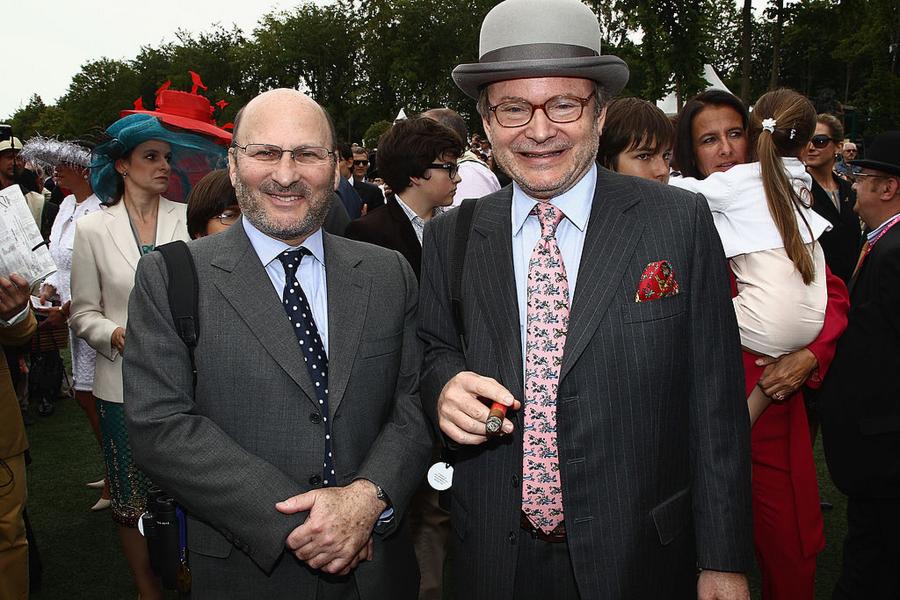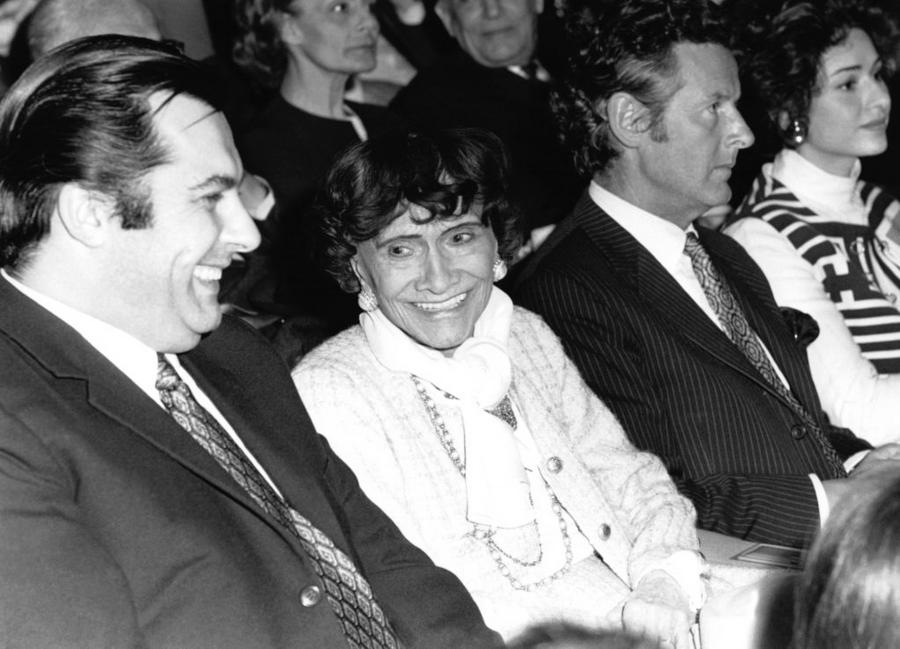What Was Coco Chanel's Net Worth?
Coco Chanel was a French fashion designer who had a net worth of $10 million at the time of her death in 1971. After adjusting for inflation that's the same as around $80 million today. Coco Chanel earned fortune and fame as the founder of the Chanel brand. She is credited with changing women's fashion in the post-World War I era and designed handbags, jewelry, and fragrances as well. Her signature scent is called Chanel No. 5. Chanel was awarded the Neiman Marcus Fashion Award in 1957. Coco has also been credited with inventing the concept of the little black dress. Coco Chanel passed away on January 10, 1971, at the age of 87. In the years since her death, while her impact on women's fashion is undeniable, her reputation has been reexamined, considering her close ties with the Nazis.
In 1924, Chanel partnered with Pierre Wertheimer and his brother Paul to create Parfums Chanel, to produce and market her fragrances. The Wertheimers received a 70% stake, while Chanel got 10% and her friend Théophile Bader received 20%. Perhaps understandably, Chanel later felt the deal was unfair and attempted to regain control of her brand during World War II. Some have even alleged that she used personal Nazi connections during the Nazi occupatin of France to regain the company from the Wertheimers, who were Jewish. She was unsuccessful because the Wertheimers had transferred ownership to a non-Jewish businessman to protect it from Nazi seizure. Amid the controversy, Coco fled to Switzerland.
While living in Switzerland, Coco created a new perfume line under her own name. The Wertheimers were incensed and actually came very close to suing her for infringing the commercial rights of their company Parfums Chanel. In 1947, Wertheimer and Chanel reached an amicable deal in which he paid her $400,000 in cash ($6 million in today's dollars), agreed to a 2% royalty from the sales of No. 5, and agreed to a perpetual monthly expense stipend. In exchange, Coco stopped selling her Swiss perfumes, relinquished her 10% ownership stake in Parfums Chanel, and sold her rights to the name "Coco Chanel." This deal effectively gave Wertheimer full control of the Chanel name and brand, while providing Chanel with financial security for the rest of her life. As a result of this deal, today, Pierre Wertheimer's two sons, Alain and Gerard, privately own 100% of the brand. They have a combined net worth of $90-100 billion.
Estate Value
In her will written on October 11, 1965, six years before her death, Chanel bequeathed her fortune (estimated by the press at $10 million at the time) to the Coga Foundation (initials of Coco and Gabrielle – her real first name) to be administered by grand-niece Gabrielle Palasse-Labrunie and a team of Swiss lawyers, responsible for paying annuities to her various beneficiaries.
Early Life
Coco Chanel was born Gabrielle Bonheur Chanel on August 19, 1883, in Saumur, France. Her parents were Eugénie Jeanne Devolle Chanel and Albert Chanel. Her mother worked as a laundrywoman in the local charity hospital, while her father was an itinerant street vendor who sold clothing and undergarments. She grew up with her older sister, Julia. The family lived a nomadic life, traveling to and from market towns and residing in various rundown lodgings. The couple went on to have four more children. Her mother died when Chanel was 11 years old, and her father sent his daughters to an orphanage run by the convent of Aubazine and his sons to work as farm laborers.
When Coco was 18, she went to live in a boarding house for Catholic girls in the town of Moulins. As she got older, Chanel would retell the story of her childhood differently, often making it more glamorous and including many details that obscured the reality of her impoverished upbringing.

Evening Standard/Hulton Archive/ Getty Images
Chanel Founding
Chanel found employment as a seamstress in Moulins. She also began singing in a cabaret and made her on-stage debut singing in a Moulins pavilion in between the main acts. It was during this time that she acquired the name Coco. While in Moulins, Chanel met a young French ex-cavalry officer and textile heir, Etienne Balsan. She became his mistress at the age of 23 and lived with him in his château for three years. In 1908, she began having an affair with one of Balsan's friends, Captain Arthur Edward "Boy" Capel. Capel installed Chanel in an apartment in Paris and financed her first shops. She had already begun designing hats while living with Balsan and became a licensed milliner in 1910, opening a boutique in Paris called Chanel Modes. She became quite popular after the theatre actress Gabrielle Dorziat wore one of her hats in a play.
In 1913, Coco opened a boutique in Deauville, which was very successful. There, she began selling deluxe casual clothing. She opened another location in Biarritz, which proved so lucrative that she was able to reimburse Capel's original investment in her business. In 1918, she purchased a building in one of the most fashionable districts of Paris and opened an early incarnation of a fashion boutique there in 1921, which featured clothing, hats, accessories, and other designs. She later expanded to offer jewelry and fragrances. By 1927, she opened five properties in the district, and her fashion line was immensely successful.
Wertheimer Deal
In the 1920s, Coco also began designing dance costumes for the Ballets Russes after developing a relationship with Russian composer Igor Stravinsky. In 1922, she was introduced to Théophile Bader, the founder of the Paris Galeries Lafayette. He was interested in selling her perfume, Chanel No. 5, in his department store. What resulted was a business deal in which the entity Parfums Chanel was created using an injection of capital from investor Pierre Wertheimer.
Under the terms of the deal, Wertheimer owned 70%, Bader owned 20%, and Coco owned just 10%. Coco would soon regret this partnership, and she forged an unsuccessful legal campaign to get the percentages renegotiated.

Julien Hekimian/WireImage/Getty Images
Nazi Collaborator & Wertheimer Buyout
By the late 1930s, before the outbreak of World War II, Chanel had established herself as the preeminent designer in Paris. However, she closed all of her shops when the war began as she said it was not the time to be focusing on fashion.
During this time, Pierre Wertheimer appointed a local Christian industrialist as a Nazi-friendly "Aryan" proxy owner of the business.
Meanwhile, during the war Coco had a romantic relationship with Baron Hans Günther von Dincklage, a German intelligence officer, which raised suspicions. Furthermore, Chanel lived in the Ritz Hotel in Paris during the Nazi occupation, a privilege afforded to few.
There are allegations that she worked as an agent for German military intelligence, with some historians claiming she was involved in operations under the codename "Westminster." Chanel reportedly used her connections to try to regain control of her perfume business.
After the war, Chanel faced questioning about her wartime activities but was never formally charged. She fled to Switzerland to avoid further scrutiny. While some defend her actions as survival tactics in a difficult time, others view them as opportunistic collaboration. The controversy continues to shadow her legacy, complicating the narrative of her life and career.
While living in Switzerland, Coco created a new perfume line under her own name. Wertheimer came very close to suing Chanel for infringing the commercial rights of their company Parfums Chanel. In 1947, Wertheimer and Chanel reached an amicable deal in which he paid her $400,000 in cash, agreed to a 2% royalty from the sales of No. 5, and agreed to a perpetual monthly expense stipend. In exchange, Coco stopped selling her Swiss perfumes, relinquished her 10% ownership stake in Parfums Chanel, and sold her rights to the name "Coco Chanel."

(Photo by Yves LE ROUX/Gamma-Rapho via Getty Images)
Legacy
In terms of her legacy, Chanel is credited with popularizing sporty, casual chic style as the feminine standard, doing away with more restricted corseted silhouettes. She is the only designer to be listed on "Time" magazine's list of the 100 most influential people of the 20th century. Many of her designs and products have become iconic, like the Chanel No. 5 perfume and the famed interlocked-CC monogram that is featured on many of her clothing, shoe, and handbag designs.
Personal Life and Death
Chanel was romantically involved with Arthur Capel for much of her life, even after Capel married an English aristocrat. They remained involved until his death in a car accident in December 1919. In 1916, while in Biarritz, Coco began a romantic relationship with the Grand Duke Dmitri Pavlovich of Russia. They maintained a close association for years. She also had a romantic relationship with composer Igor Stravinsky throughout the 1920s and 1930s, unbeknownst to Stravinsky's wife.
Chanel maintained a very close personal friendship with Misia Sert, a member of the bohemian elite in Paris. The two female friends also developed a regular drug use habit together, as Coco became a habitual drug user and injected herself with morphine on a daily basis until the end of her life. She also developed a reputation for throwing lavish, drug-filled parties in Paris.
Chanel later developed relationships with some of the British aristocracy. In particular, she had an affair with the Duke of Westminster, Hugh Richard Arthur Grosvenor. He was an outspoken antisemite, which likely influenced Chanel's own opinions about the Jewish people. During World War II, Chanel lived in the Hotel Ritz in Paris while the city was occupied by the Germans. Notably, the hotel was the preferred place of residence for German military staff, and Chanel was said to be a sympathizer of the Nazis, as she had romantic liaisons with high-ranking German military members. In late 2014, French intelligence agencies confirmed that Coco had actually been working as a spy for the Germans during World War II and had been instrumentally involved in a plan to help the Third Reich take control of Madrid. She reportedly had committed herself to the German cause by 1941 and reported to General Walter Schellenberg, the head of the German intelligence agency. He was later sentenced to six years in prison by the Nuremberg Military Tribunal. After his release in 1951, Chanel financially supported his family and paid for his medical care and living expenses. When the war ended, Chanel fled to Switzerland to avoid criminal charges for collaborating with the Nazis. Reportedly, Winston Churchill, whom Chanel had previously developed a friendship with, intervened to protect Chanel from punishment, allowing her to return to Paris.
Chanel died in January 1971 at the Hotel Ritz, where she had lived for over 30 years. Her funeral was attended by models and fashion designers.
/2023/04/coco-chanel2-1.jpg)
/2020/05/gw.jpg)
/2015/07/Christian-Dior.jpg)
/2011/07/Pierre-Cardin-e1609263950864.jpg)
/2016/08/GettyImages-458777384.jpg)
/2018/08/Yves-Saint-Laurent.jpg)
/2019/01/James-Altucher.jpg)
/2013/12/dan.jpg)
/2011/12/John-Mara-1.jpg)
/2010/12/kate-1.jpg)
/2020/10/the-miz.png)
/2011/12/Rooney-Mara1.jpg)
/2020/08/gc-1.jpg)
/2014/04/GettyImages-886617106.jpg)
/2011/01/Aaron-Rodgers.jpg)
/2022/10/peter-krause.jpg)
/2010/03/emil.jpg)
/2023/04/coco-chanel2-1.jpg)
/2020/05/gw.jpg)
/2015/09/Alain-Wertheimer.jpg)
/2016/02/GettyImages-488162724.jpg)
/2010/05/Tory-Burch.jpg)
/2015/07/Christian-Dior.jpg)
/2018/06/ks.jpg)